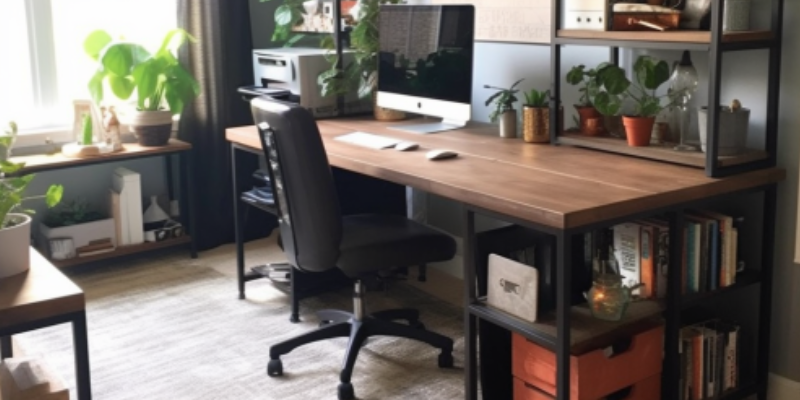Are you exhausted from the drudgery of cubicle life or the endless hunt for a quiet coffee shop corner? Your search ends here if you’re a freelancer seeking comfort, convenience, and peak productivity. Welcome to our comprehensive DIY Home Office Setup Checklist, exclusively tailored for modern freelancers like you.
DIY Home Office Setup Checklist
Embracing the work-from-home lifestyle has its advantages, but the key to leveraging these perks is creating an inspiring workspace that empowers you. Whether you’re a writer, designer, consultant, or any other independent professional, your home office can become a sanctuary of productivity and creativity.
This all-inclusive checklist delves into the essential elements that contribute to a highly efficient and personalized home office. We cover everything from ergonomics and organization to lighting and tech must-haves. It’s time to say farewell to battling distractions and discomfort and hello to a workspace that sparks joy and fuels your freelance success.
So, prepare your favorite hot drink, find a comfortable spot, and embark on this exciting journey to create your DIY home office setup. Prepare to unlock your creativity, supercharge your productivity, and revolutionize your work-from-home routine. It’s time to redefine how you work as a modern freelancer!
The Power of a Well-Designed Home Office for Freelancers

In the fast-paced and ever-evolving world of freelancing, where flexibility and autonomy reign supreme, one element stands out as a game-changer: a well-designed home office.
As a freelancer, your workspace shapes your productivity, creativity, and overall work experience.
Gone are the days of being confined to rigid office spaces or dealing with the endless distractions of public workspaces. With the freedom to work from the comfort of your home, you can create a workspace that aligns perfectly with your work style and preferences.
A well-designed home office is about more than just aesthetics. It’s about creating an environment that nurtures your focus, fosters creativity, and boosts efficiency. It’s the space where ideas flow freely, you feel inspired to tackle new challenges, and your professional aspirations can thrive.
When thoughtfully designed, your workspace becomes a sanctuary of productivity, a haven where you can fully immerse yourself in your craft. It’s a place to seamlessly transition between tasks, find your flow, and accomplish your goals.
The importance of a well-designed home office extends beyond mere convenience. It can profoundly impact your mental and physical well-being, enhancing your work-life balance and overall job satisfaction. A space that supports your comfort, health, and focus can contribute to higher-quality work, improved client relationships, and a stronger sense of professional fulfillment.
Understanding Your Freelance Workspace Needs

As a freelancer, your workspace transcends the notion of a mere physical location; it becomes an integral part of your professional journey.
Recognizing your unique workspace requirements is paramount to crafting an effective home office setup.
1. Evaluate Your Work Tasks and Activities
Commence with an analysis of your work’s nature. Take into account regular tasks and activities. Do your responsibilities lean towards creative, analytical, or perhaps a blend? Grasping the specifics of your work aids in aligning your workspace to your tasks.
2. Determine the Space Available
Inspect your home for potential workspace locations. Consider the room’s dimensions, available surfaces, and storage possibilities. Ensuring adequate space for your necessary equipment, furniture, and supplies is crucial.
3. Consider Privacy and Distractions
Reflect on your work’s privacy requirements. If tranquillity is necessary, opt for a home location that minimizes distractions. Consider the proximity to common areas, noise levels, and potential disturbances.
4. Identify Equipment and Tools
Catalog the equipment, tools, and technology essential for your work. This could include a computer, specific software, peripherals like printers or scanners, and any specialized equipment your field requires. Make sure your workspace can accommodate these important items.
5. Assess Storage and Organization Needs
Evaluate your storage requirements for work materials, files, and supplies. Consider storage solutions that enhance your workflow, whether it’s filing cabinets, shelves, or digital storage alternatives. A well-organized workspace fosters efficiency and productivity.
6. Reflect on Comfort and Ergonomics
Given freelancers’ extensive hours at their desks, comfort is paramount. Evaluate your seating arrangements, desk height, and overall workspace ergonomics to foster good posture, diminish strain, and mitigate discomfort or injury risk.
By understanding your freelance workspace needs, you’re equipped to design a home office that supports your work style, bolsters productivity, and contributes to your overall well-being.
Designing Your Ideal Home Office Setup

Choose the Right Location
Selecting an optimal location within your home is crucial to crafting your ideal home office setup.
A dedicated workspace not only enhances your productivity but also aids in delineating a clear distinction between your personal and professional domains.
Here are some tips to consider for finding the perfect spot:
- The Power of a Dedicated Workspace
Creating an exclusive space for work fosters an atmosphere of concentration and professionalism. It triggers a productive mindset and effectively separates work hours from personal downtime. - Keep Noise Levels in Check
Assess the noise levels in potential workspace areas in your home. Opt for a space away from busy sites or constant noise sources, like the kitchen or the living room, to limit distractions and interruptions. - Harness Natural Light and Views
Evaluate potential spots for natural light availability. Natural light creates a warm, refreshing ambiance and boasts several health benefits. Choose a spot that offers a lovely view, be it a glimpse of your garden or the outside world. A pleasing vista can help alleviate eye strain and boost your overall mood. - Space and Privacy Matters
Ensure your chosen spot provides ample space to fit all your work essentials comfortably. It should accommodate your desk, chair, storage options, and equipment. Also, consider the privacy level your work requires. A quiet, private space with minimal background noise is ideal if your job involves regular client calls or video conferences. - Lighting and Ventilation are Crucial
Examine the artificial lighting options in your chosen location. Adequate lighting is vital to prevent eye strain and maintain focus. Consider investing in task lamps or adjusting the fixtures if the lighting is insufficient. Similarly, ensure the space offers proper ventilation to maintain a fresh and comfortable working environment.
When you consider these factors, you’ll be able to create an inspiring workspace that stimulates focus and productivity while promoting a healthier work-life balance.
Ergonomics for Productivity and Health
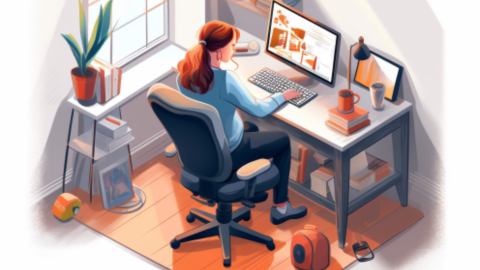
The Ergonomic Edge
When it comes to creating a home office that bolsters productivity and physical health, incorporating ergonomics in your workspace is paramount.
Ergonomics is the design science of tailoring equipment and furniture to meet human needs, ensuring comfortable and efficient work conditions.
This section delves into the significance of ergonomic furniture and equipment and suggests top-notch ergonomic chairs, desks, and accessories.
Investing in ergonomic furniture and tools is vital for safeguarding your health, lowering the risk of musculoskeletal issues, and boosting productivity. Ergonomic items support proper posture, minimize strain, and offer comfort during extended work hours.
- The Ergonomic Chair
Your office chair is undoubtedly the fulcrum of your home office. Seek an ergonomic chair with adjustable height, lumbar support, and adequate cushioning. Renowned choices include the Herman Miller Aeron, Steelcase Gesture, and Autonomous Premium. - The Ergonomic Desk
A thoughtfully designed ergonomic desk can revolutionize your work experience. Opt for a desk with height adjustability, allowing you to alternate between sitting and standing positions. Consider the Vari Electric Standing Desk, Vari Electric Standing Desk, or the Flexispot Electric Standing Desk. - Ergonomic Keyboard and Mouse
Ergonomic keyboards and mice aim to reduce strain on your wrists and hands. Look for split designs or ergonomic contours, such as those offered by the Logitech MK570 Wireless Wave Keyboard. Similarly, consider an ergonomic mouse like the Logitech MX Vertical or the Anker Ergonomic Optical Mouse. - Monitor Setup
Ensure your monitor is placed at eye level to mitigate strain on your neck and back. You might find an adjustable monitor stand or an ergonomic monitor arm helpful in achieving the optimal viewing height. Brands like Ergotron, Fleximounts, and Ergotech provide diverse monitor mounting solutions. - Comfort Accessories
Boost your ergonomic setup with accessories like an adjustable monitor riser, a document holder for reducing neck strain, a footrest for improved circulation, and wrist rests for added keyboard and mouse support.
Remember, ergonomics extends beyond furniture and equipment. Incorporate regular breaks, stretching exercises, and good posture to enhance your physical well-being during the workday.
Integrating ergonomic furniture and accessories into your home office allows you to cultivate a workspace that places a premium on your health, enhances productivity, and minimizes the risk of work-related ailments.
Organization and Storage Solutions
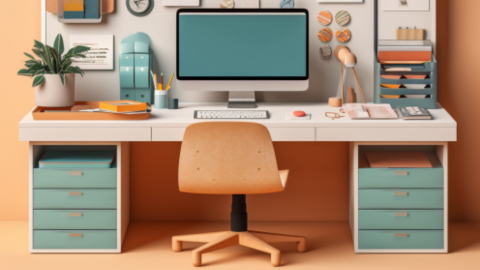
Ensuring an orderly workspace is crucial to enhancing efficiency, minimizing distractions, and fostering a clear mind. A workspace free from clutter allows you to concentrate on your tasks and locate everything you need effortlessly.
This section underscores the value of an orderly home office and offers practical advice on storage options, filing systems, and desk organization.
The Power of an Orderly Workspace
An orderly workspace lays the groundwork for a productive working environment. When each item has its designated place and is easily accessible, you can operate more efficiently and decrease the time spent hunting for documents, supplies, or tools. Moreover, a neat workspace positively influences mental well-being, reducing stress and enhancing concentration.
1. Storage Solutions
Consider integrating the following storage solutions into your home office setup:
- Shelves and Cabinets: Incorporate shelves or cabinets to house books, files, and office equipment. Utilize vertical space to maximize storage capacity.
- Filing Systems: Develop a filing system that suits your needs, whether a classic file cabinet, a filing box, or a digital filing system. Organize and label files for easy retrieval.
- Desk Organizers: Employ desk organizers like trays, drawer dividers, or pen holders to keep essential items within reach and systematically arranged.
- Storage Bins and Boxes: Use storage bins and boxes for items that are not frequently used, keeping your workspace devoid of unnecessary clutter.
2. Digital Organization
In addition to physical organization, digital organization is equally vital for freelancers. Implement these strategies:
- Cloud Storage: Use cloud storage services like Google Drive, Dropbox, or OneDrive for storing and accessing your digital files from anywhere. Organize files into folders and establish a consistent naming convention.
- Digital Task Management: Leverage task management tools such as Trello, Asana, or Todoist to structure and prioritize your tasks, deadlines, and project specifics.
3. Minimalism and Decluttering
Adopt the principles of minimalism by regularly decluttering your workspace. Evaluate your belongings and discard items that are obsolete or don’t serve a purpose. Retain only the essentials to create a clean and focused environment.
4. Cable Management
Combat cable chaos in your home office with effective cable management solutions. Here are some tips:
- Use cable clips, sleeves, or trays to keep your cables orderly and prevent tangling.
- Secure and guide your cables along the edge of your desk or behind furniture using cable clips or adhesive mounts.
- Bundle and hide multiple cables with cable sleeves or wire covers to diminish visual clutter and reduce tripping hazards.
- Use cable management boxes to contain and conceal excess cables and power strips, fostering a tidy and organized workspace.
Remember, organizing your home office is a continuous process. Adopt the following habits to maintain an orderly workspace:
- Carve out time to declutter, reorganize, and reevaluate your storage requirements.
- Consider cable trays, under-desk cable management systems, or wall-mounted cable organizers to create dedicated spaces for routing and storing your cables.
Adhering to these effective cable management solutions and maintaining an orderly workspace can eradicate cable chaos and relish a streamlined and efficient home office. Embrace these practices to declutter your workspace, boost your productivity, and create a harmonious work environment that bolsters your professional pursuits.
Personalization and Inspiration
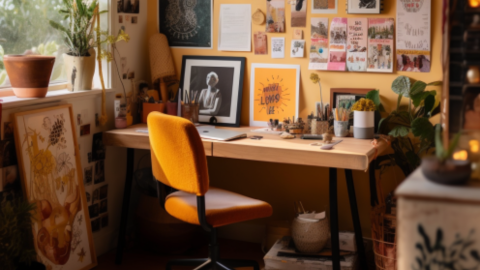
Your home office is more than just a functional workspace. It mirrors your personality and fosters creativity.
Adding personal touches and crafting an inspiring environment can significantly amplify your motivation, focus, and overall satisfaction with your work.
Adding Personal Touches
First and foremost, your home office should reflect your unique style and interests. Here are some ways to infuse personal touches:
- Decorate with Meaningful Items: Display personally significant items like photographs, artwork, or travel souvenirs. You can potentially enhance your mood and motivation by surrounding yourself with inspiring and memory-evoking things.
- Incorporate Your Favorite Colors: Choose a color scheme that resonates with your personality and promotes a calm or creative environment. Use paint, wall art, or accent pieces to introduce your favorite colors into the space.
- Showcase Hobbies or Collections: If you’re a hobbyist or collector, incorporate these interests into your workspace. For instance, if you’re a book lover, set up a dedicated bookshelf or reading nook. For music enthusiasts, display your instruments or album covers.
Creating an Inspiring Environment
Next, an inspiring environment is crucial to fueling your creativity and promoting well-being. Here are some suggestions:
- Natural Elements: Introduce elements of nature into your workspace by adding plants, flowers, or a mini indoor garden. This can improve air quality and mood and foster a calming atmosphere.
- Inspirational Quotes or Mantras: Display motivational quotes or affirmations that resonate with you. Use wall decals, sticky notes, or a personalized vision board as constant reminders of your goals and aspirations.
- Vision and Inspiration Boards: Create a vision or inspiration board to pin images, quotes, and ideas that inspire you. It serves as a visual representation of your dreams, keeping you focused and motivated.
- Comfortable Seating and Relaxation Area: Consider creating a comfy seating area or cozy corner for breaks, meditation, or creative thinking away from your desk.
- Music and Ambiance: Curate a playlist that helps you concentrate or sparks creativity. Use a speaker system or headphones to immerse yourself in your favorite tunes.
Personalizing your home office and designing an inspiring environment will make you feel more connected to your work and find greater joy and fulfillment in your freelance journey.
Essential Tech Gadgets for Freelancers
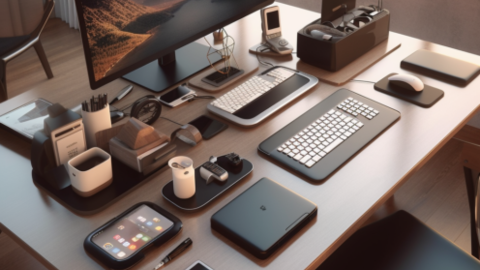
Technology empowers freelancers to work efficiently and connect with clients and colleagues in the digital age.
Equipping your home office with the right tech gadgets can significantly enhance productivity, streamline workflows, and ensure seamless communication. In this section, we’ll explore a range of essential tech gadgets that freelancers should consider incorporating into their setup. From boosting your productivity to improving connectivity, these gadgets are designed to make your freelance journey smoother and more successful.
10 Tech Gadgets Every Freelancer Needs
1. High-Performance Laptop or Desktop Computer
A reliable and robust computer is the backbone of any freelance operation. Invest in a high-performance laptop or desktop computer that meets your needs and allows you to run resource-intensive software, handle multitasking, and deliver projects efficiently. The MacBook Pro, known for its speed, performance, and sleek design, is a popular choice among freelancers in creative fields.
2. Dual Monitors or Ultrawide Display
Expand your screen real estate and improve multitasking capabilities with dual monitors or an ultrawide display. This setup lets multiple applications, documents, or webpages open simultaneously, enhancing your efficiency and workflow organization. The Dell Ultrasharp U3415W offers an immersive ultrawide display, allowing multiple windows to open side by side, increasing productivity and reducing the need for constant window switching.
3. Wireless Keyboard and Mouse
Embrace the freedom from cables with a wireless keyboard and mouse. This setup reduces clutter on your desk and provides greater flexibility in positioning, allowing you to find the most comfortable and ergonomic working posture. The Logitech MX Keys wireless keyboard and MX Master 3 mouse offer precision, comfort, and seamless connectivity, enhancing your typing and navigation experience.
4. Noise-Canceling Headphones
Block out distractions and create a focused work environment with noise-canceling headphones. The Sony WH-1000XM4 wireless headphones provide industry-leading noise cancellation, exceptional sound quality, and long-lasting comfort.
5. Webcam and Microphone
Deliver professional-grade video calls and virtual meetings with a high-quality webcam and microphone. The Logitech C920 HD Pro webcam and Blue Yeti USB microphone offer superior image quality and crystal-clear audio.
6. Portable External Hard Drive or Cloud Storage
Safeguard your files, documents, and project backups with a portable external hard drive or cloud storage solution. The Samsung T5 Portable SSD provides high-speed, compact storage.
7. Task Management and Collaboration Tools
Streamline your project management and team collaboration with task management and collaboration tools like Trello, Asana, and Monday.com.
8. Wireless Charging Pad
Keep your devices powered up and eliminate the hassle of tangled cords with a wireless charging pad. The Anker PowerWave wireless charging pad offers fast and convenient wireless charging.
9. Smart Assistant Speaker
Boost your productivity and simplify tasks with a smart assistant speaker. The Echo Dot (5th Gen, 2022 release) with clock and Alexa voice assistant offers a range of features to enhance your productivity.
10. USB Hub or Docking Station
Expand the connectivity options of your laptop or desktop computer with a USB hub or docking station. The CalDigit TS3 Plus Thunderbolt 3 Dock offers a wide range of ports.
Remember, the specific tech gadgets you choose will depend on your workflow, preferences, and budget. Consider your unique needs and prioritize the devices significantly impacting your freelance work. Integrating these essential tech gadgets into your home office will create an environment that maximizes your productivity, efficiency, and enjoyment.
Budget-Friendly Tips for DIY Home Office Setup
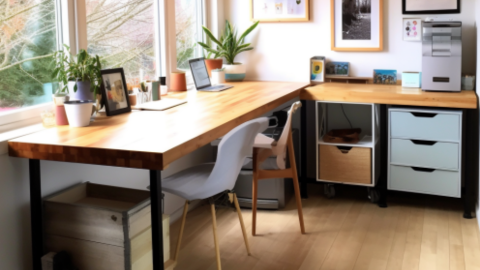
Creating a Professional and Functional Home Office on a Budget
Creating a professional and functional home office doesn’t have to break the bank. With creativity and resourcefulness, you can set up a productive workspace that fits your style and budget. Here are nine budget-friendly tips and alternatives for DIY home office setups.
1. Repurpose Furniture
Look around your home for furniture pieces that can be repurposed for your home office. A sturdy dining table can be a spacious desk, while a bookshelf can store office supplies and equipment. Get creative and repurpose what you already have before investing in new furniture.
2. Thrift Stores and Online Marketplaces
Explore thrift stores, consignment shops, and online marketplaces for affordable furniture and equipment options. You can often find gently used desks, chairs, and storage solutions at a fraction of the cost of new items. Remember to inspect the items for quality and functionality before purchasing thoroughly.
3. DIY Desk and Shelves
If you have basic carpentry skills, consider building your desk or shelves. You can find plenty of DIY plans and tutorials online to guide you through the process. Building your furniture allows you to customize the design and dimensions while keeping costs low.
4. Secondhand Electronics
Consider purchasing secondhand electronics from reputable sources, such as computers, monitors, and printers. Many individuals and businesses sell their gently used electronics at lower prices, providing you with cost-effective options without compromising on functionality.
5. Online Discounts and Sales
Watch for online discounts, promotions, and office furniture and equipment sales. Subscribe to newsletters of office supply stores and online retailers to stay informed about upcoming deals. Taking advantage of these offers can significantly reduce your expenses.
6. Free and Open-Source Software
Opt for free or open-source software alternatives to costly productivity tools. Many applications offer similar features to their premium counterparts, allowing you to save money without sacrificing functionality. Explore options like Google Docs, LibreOffice, and Trello for your productivity and collaboration needs.
7. Energy-Efficient Lighting
Choose energy-efficient LED bulbs for your desk lamp or overhead lighting. LED bulbs are long-lasting and consume less electricity, reducing energy costs in the long run. Additionally, utilize natural lighting by positioning your desk near a window, harnessing natural light during the day.
8. Thrifty Decor and Personalization
Decorate your home office with inexpensive, thrifty decor items to add a personal touch. Browse thrift and craft stores or even repurpose household items as decor accents. This allows you to create a visually appealing and inspiring workspace without breaking your budget.
9. Office Supplies on a Budget
Shop for office supplies strategically by comparing prices and buying in bulk. Look for discounts and consider store brands or generic alternatives for paper, pens, notebooks, and printer ink. This way, you can save money while ensuring you have the necessary supplies.
Setting up a budget-friendly home office doesn’t mean compromising quality or functionality. With some planning and resourcefulness, you can create a comfortable and efficient workspace that supports your freelance endeavors without draining your bank account.
Maximizing Productivity in Your Home Office

Working from home offers flexibility and freedom but presents unique challenges to maintaining productivity.
This section presents ten actionable tips and strategies designed to amplify home office productivity.
These tips aim to streamline your workflow, mitigate distractions, and ensure an optimal balance between work and leisure, leading you to a superior work-from-home experience.
Boosting Home Office Productivity: Top 10 Strategies
1. Establish a Routine
Set a consistent schedule and establish a daily routine that aligns with your most productive hours. Having a structured way helps create a sense of normalcy and sets clear boundaries between work and personal life.
2. Create a Dedicated Workspace
Designate a specific area in your home solely for work purposes. This dedicated workspace helps you mentally shift into work mode and minimizes distractions from household activities. Ideally, choose a quiet and well-lit area that promotes focus and concentration.
3. Set Clear Goals and Priorities
Start each day by outlining your goals and priorities. Set realistic expectations and break larger tasks into smaller, manageable chunks. Prioritize your tasks based on importance and deadlines to stay on track and focus.
4. Minimize Distractions
Identify potential distractions in your home and take proactive steps to minimize them. This may involve closing unnecessary tabs on your web browser, silencing notifications on your phone, or using noise-canceling headphones to block out external noises.
5. Time Blocking
Use the time-blocking technique to schedule specific time slots for different tasks or activities. You can maintain productivity and ensure a healthy work-life balance by allocating dedicated blocks of time for focused work, breaks, and personal activities,
6. Practice Effective Time Management
Use productivity tools or apps to manage your time effectively. Set timers or use the Pomodoro Technique to work in focused bursts with short breaks in between. Experiment with different methods to find what works best for you.
7. Optimize Your Digital Workspace
Organize your digital files and folders in a logical and accessible manner. Utilize productivity apps, project management tools, and cloud storage to streamline your workflow and collaborate efficiently with clients or team members.
8. Take Regular Breaks
Incorporate short breaks throughout your workday to recharge and avoid burnout. Engage in activities that refresh your mind and body, such as stretching, walking, or practicing mindfulness exercises.
9. Stay Connected with Others
Combat feelings of isolation by maintaining regular communication with colleagues, fellow freelancers, or industry peers. Schedule virtual coffee chats, participate in online forums, or join professional networking groups to stay connected and exchange ideas.
10. Practice Self-Care
Prioritize self-care to maintain overall well-being and enhance productivity. Get enough sleep, eat nourishing meals, exercise regularly, and engage in activities that bring you joy and relaxation. Remember, a healthy and balanced lifestyle supports your professional success.
By implementing these strategies and tips, you can create a productive environment in your home office and optimize your work-from-home experience. Productivity is a journey; finding what works best for you is essential. Experiment with different techniques and adapt them to your unique needs and preferences.
Remember to check out the upcoming section on digital tools and apps for freelancers to discover how technology can further enhance your workflow and take your freelance career to new heights.
Leveraging Technology for Freelancers

In today’s digital age, technology plays a pivotal role in the success of freelancers. It offers many digital tools and applications that streamline workflows, enhance communication, and boost productivity.
In this section, we’ll guide you through the effective use of technology in accelerating your freelance career.
Get ready to uncover seven essential digital tools and apps to catapult your freelance productivity to greater heights.
7 Essential Digital Tools: Empowering Your Freelance Productivity
- Project Management Platforms
Stay organized and collaborate seamlessly with project management platforms like Trello, Asana, or Monday.com. These tools allow you to create task boards, assign deadlines, track progress, and communicate efficiently with clients or team members. - Time-Tracking Apps
Keep track of your billable hours and improve time management with time-tracking apps such as Toggl, Harvest, or Clockify. These tools help you monitor how much time you spend on each project, set project budgets, and generate accurate invoices. - Communication and Collaboration Tools
Foster effective communication and collaboration with clients and team members using tools like Slack, Microsoft Teams, or Google Meet. These platforms offer real-time messaging, video conferencing, file sharing, and screen sharing, enabling seamless remote collaboration. - Cloud Storage and File Sharing
Store and access your files securely from anywhere with cloud storage services like Google Drive, Dropbox, or OneDrive. These platforms offer ample storage space, automatic syncing across devices, and easy file sharing, ensuring your essential documents and files are at your fingertips. - Invoicing and Accounting Software
Simplify your invoicing and accounting processes with software like QuickBooks, FreshBooks, or Wave. These tools enable you to create professional invoices, track expenses, manage cash flow, and generate financial reports, making it easier to manage your freelance finances. - Virtual Assistant Apps
Streamline administrative tasks and stay organized with virtual assistant apps like Evernote, Todoist, or Notion. These apps help you create to-do lists, set reminders, organize project notes, and manage your schedule, freeing up more time for your core freelance work. - Social Media Management Tools
Boost your online presence and manage your social media accounts effectively with tools like Hootsuite, Buffer, or Sprout Social. These platforms allow you to schedule and automate social media posts, analyze engagement metrics, and interact with your audience efficiently.
By embracing these digital tools and apps, you can optimize your workflow, improve collaboration, and enhance your freelance productivity. Explore the options available, experiment with different devices, and find the ones that best align with your specific needs and preferences.
Your Checklist Completed: The Next Steps in Your Home Office Journey

Bravo! You’ve successfully navigated our comprehensive checklist for creating an effective home office.
Remember, your workspace should echo your unique needs, promoting optimal productivity.
Consider your workspace arrangement, invest in ergonomic comforts, optimize lighting and organization, and harness technology’s productivity-boosting powers.
Now, transform knowledge into action! Apply our strategies, test various tools and techniques, and carve out a home office that’s a wellspring of creativity and efficiency.
Prioritise self-care and a balanced work-life rhythm. Regular breaks, clear boundaries, and stimulating activities are essential. Remember, a relaxed freelancer is a productive one!
Never cease learning. Stay current with industry trends, invest in professional growth, and discover new skills to broaden your freelancing horizons. Adaptability is key in the fluid landscape of remote work.
With this guide, you’re ready to steer your freelance career and cultivate a workspace that sparks creativity, fuels productivity, and drives you toward your goals.
Embrace the freelance lifestyle and realize your dream career. Your home office is now the launchpad for your journey.
Here’s to a thriving home office and an inspiring, productive, and fulfilling freelance journey. You’re all set for success!
